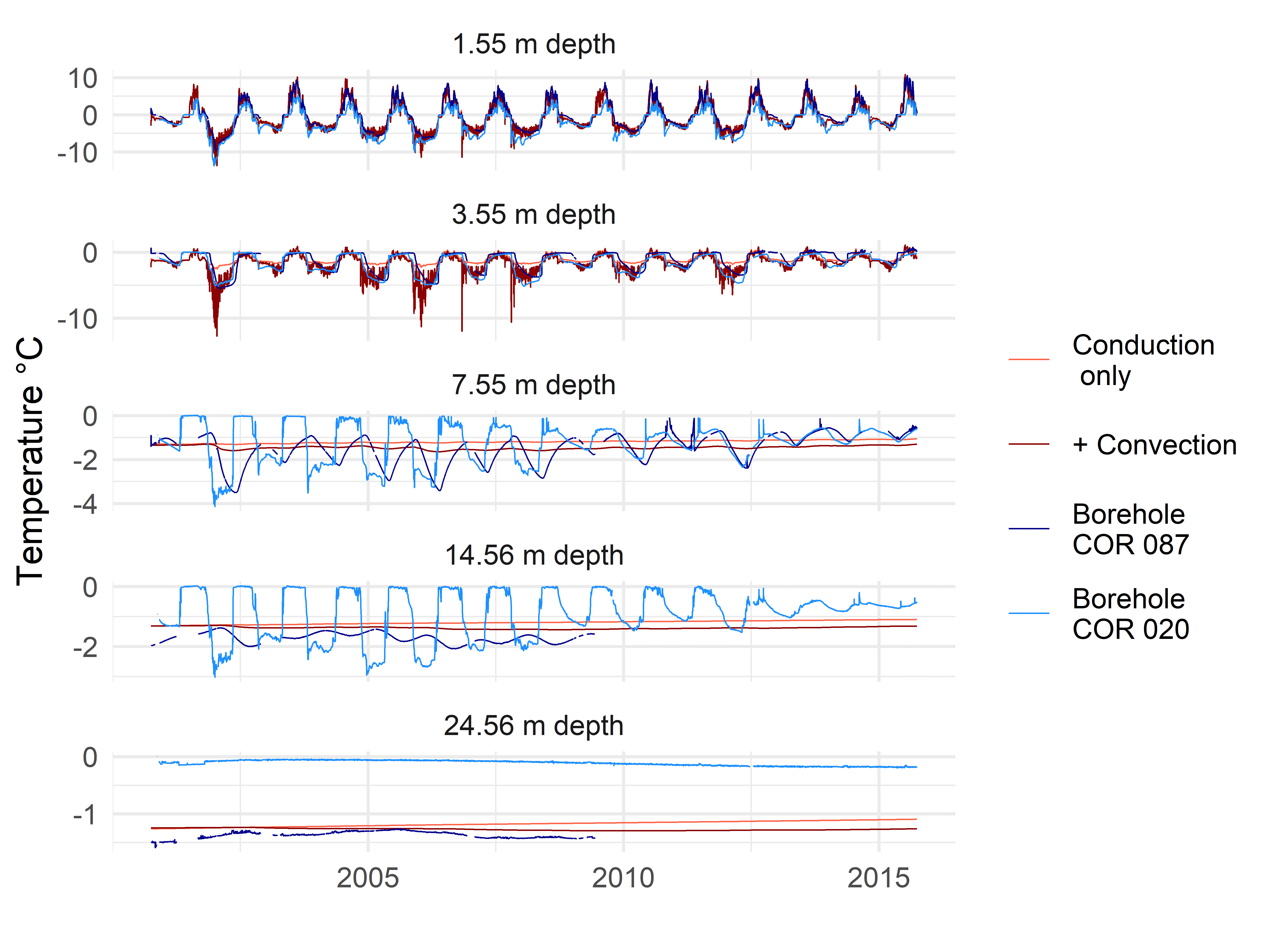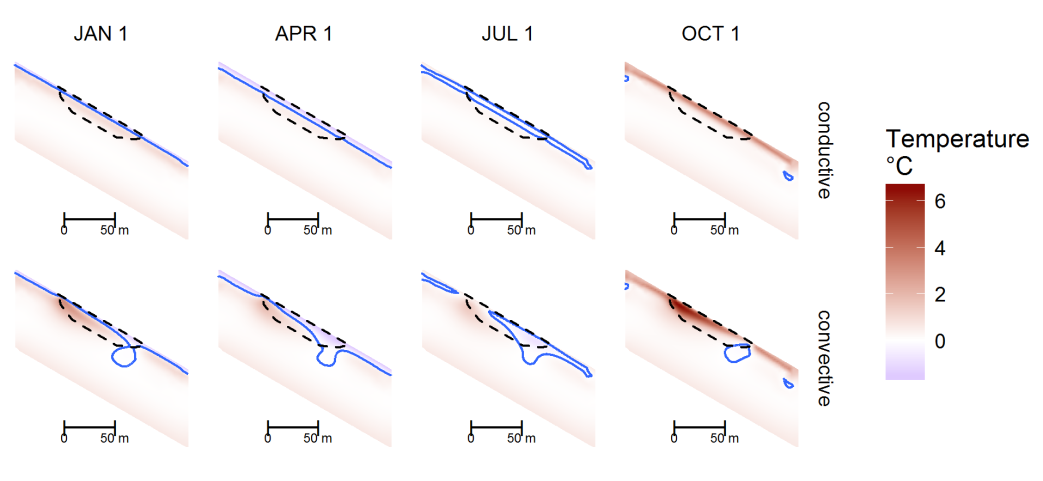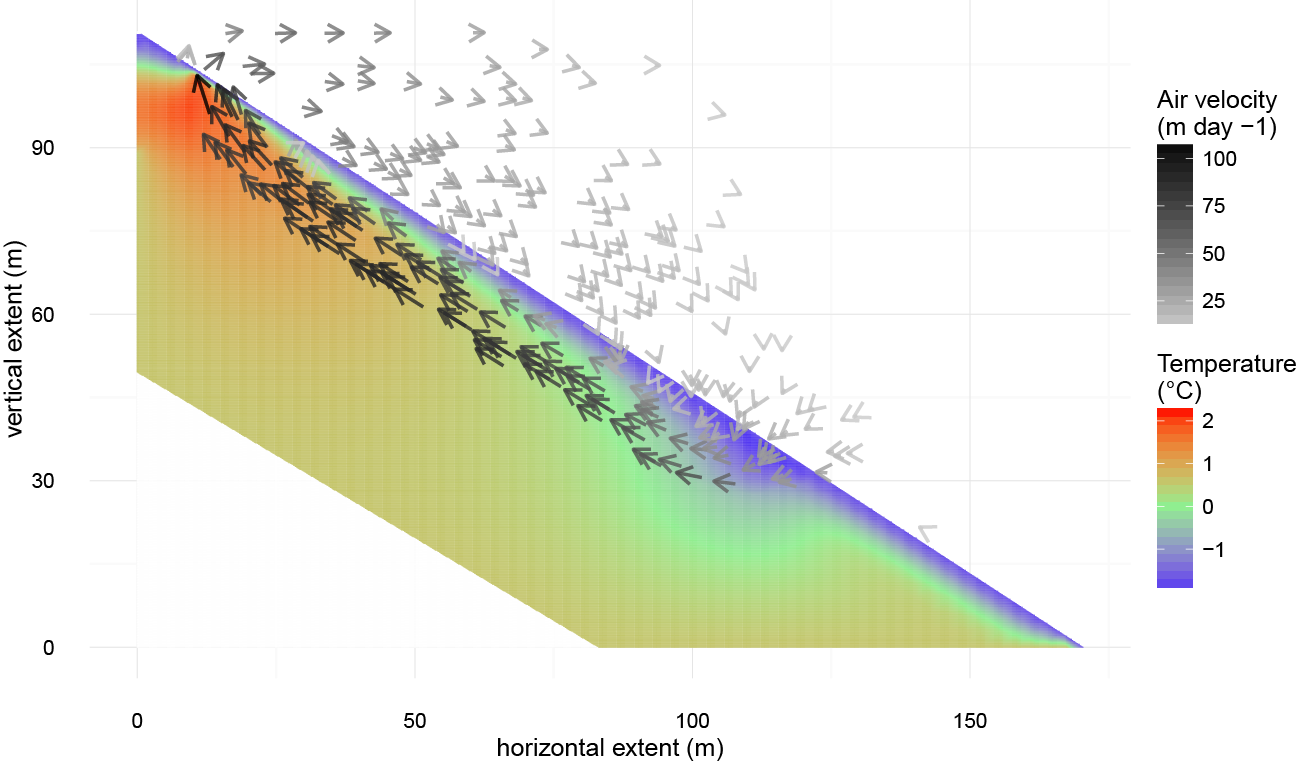Modelling of air circulation and energy fluxes in the coarse debris layer of high Alpine permafrost sites (MODAIRCAP)
Mountain permafrost is currently undergoing substantial changes due to climate change as a whole and especially due to the observed and projected air temperature increase. Among the typical mountain permafrost substrates, i.e. rock, fine sediments and coarse blocky surfaces, the latter play an important role because of their high insulating characteristics for the subsurface underneath due to the low thermal conductivity of the air voids between the blocks. In addition, air convection with upward transport of warmer air from the permafrost body and downward transport of cold air from the surface can take place within the coarse blocky layer, both, vertically (in flat terrain) as well as in form of a 2-dimensional slope circulation. These two effects lead to (i) low altitude permafrost occurrences in form of undercooled scree/talus slopes, (ii) persisting permafrost occurrences at the lower limit of permafrost (in form of rock glaciers, ice-cored moraines and talus slopes) and (iii) much colder surface and subsurface temperatures for surfaces with coarse blocky surface layers.
In this project, we will use and adapt the modelling concepts from civil engineering to model heat transfer in air flow in talus slopes and rock glaciers, and quantify the cooling effect in comparison with the other terms of the energy balance determined by existing energy balance approaches .
Research aims :
This project has the following objectives:
- Adapt existing concepts from engineering sciences that have already been tested for permafrost applications in real field cases in the Swiss Alps to enhance the understanding of convective processes in the ground.
- Quantify the amount of cooling due to convective air circulation within the coarse blocky layer to assess (i) the influence on the ground thermal regime, (ii) its importance for the energy balance and (iii) the development under climate warming.
- Validate the simulation results by ground surface temperature and borehole temperature data from the PERMOS network
-
Illustrations
Typical circulation patterns within the active layer of a rock glacier.
Note the multicellular convection during winter (left) which enhances ground cooling, and the gentle down flow during summer (right), which favors conductive heat transfer (Wicky & Hauck 2018b) .
Temperature evolution for modelled (red) and measured (blue) values over 16 years for different depths at the Murtèl rock glacier.
Model data are extracted from a virtual borehole in the center of the calculated domain. Measured data are from two boreholes (COR087 and COR020), which are next to each other on the Murtèl rock glacier (PERMOS 2016; Wicky & Hauck 2018c).
Evolution of temperature within a talus slope.
The upper series shows a simulation with only conductive heat transfer, whereas the lower series includes convection. Permafrost persist at the foot of the talus slope thanks to air convection within the talus (Wicky & Hauck 2017b).
Simulated temperature distribution (colours) and air current vectors in a talus slope for an open-to-atmosphere boundary for day 300 (winter circulation)
The intensity of the circulation is marked by the grey/black colour of the vector arrows and is given in m day-1 (Wicky & Hauck 2017a).
-
Publications
- Wicky, J. and Hauck, C. (2019a). Numerical Modeling of Convective Heat Transfer in Porous Permafrost in the Swiss Alps. COMSOL Geoscience Day 2019, Fribourg, Switzerland (Keynote Talk).
- Wicky, J. and Hauck, C. (2019b). Air Convection Within the Active Layer of an Alpine Rock Glacier: A Numerical Modelling Approach. EGU 2019, Vienna, Austria (Talk).
- Wicky, J. and Hauck, C. (2018a). Assessing the influence of convection in the active layer of a rock glacier on ground temperatures. SGM 2018, Bern, Switzerland (Talk).
- Wicky, J. and Hauck, C. (2018b). Modeling Convective Heat Transfer in the Porous Active Layer of an Alpine Rock Glacier. COMSOL Conference 2018, Lausanne, Switzerland (Conference paper and Poster).
- Wicky, J. and Hauck, C. (2018c). Convective Heat Transfer in Coarse Permafrost Substrate - A Numerical Model Study in the Swiss Alps. EUCOP 2018, Chamonix, France (Poster).
- Wicky, J. and Hauck, C. (2018d). Modelling Convective Heat Transfer in Alpine Permafrost. POLAR 2018, Davos, Switzerland (Talk).
- Wicky, J. and Hauck, C. (2017a). Numerical modelling of convective heat transport by air flow in permafrost talus slopes. The Cryosphere 11(3): 1311-1325.
- Wicky, J. and Hauck, C. (2017b). Influence of slope angle on the convective heat transfer in porous permafrost substrate. SGM 2017, Davos, Switzerland (Poster).




